Engadget has been testing and reviewing consumer tech since 2004. Our stories may include affiliate links; if you buy something through a link, we may earn a commission. Read more about how we evaluate products.
Gogoro's Eeyo 1s is so light you almost forget it's an e-bike
A practical but expensive solution for city dwellers.
Most commuter e-bikes are heavy. The vast majority have steel or aluminum frames which require a powerful motor and large battery to move. They're great to ride -- the electric assistance more than makes up for the weight -- but difficult to carry up a flight of stairs or lift onto a wall stand at home. Gogoro, however, is taking a different approach. The Taiwanese company, best known for its plethora of hip electric scooters, has built its first e-bikes with lighter carbon fiber instead. In theory, they shouldn't require as much power to move and, by extension, such a large battery pack.
That weight reduction comes at a cost, though. The regular Eeyo 1, which complements its carbon frame and fork with an alloy seatpost, handlebars and rims, costs $3,899. The lighter Eeyo 1s, which is almost completely carbon, will set you back $4,599. That’s not absurd for a carbon fiber bicycle, but it’s far more than what you would pay for a heavier e-bike option by VanMoof, Cowboy, Coboc and countless other manufacturers.
So is the price worth it? And has Gogoro struck the right balance between weight, motorized power and so-called ‘smart’ bike features? After riding more than 90 miles on the Eeyo 1s, I have a pretty good idea.
Design

One of my colleagues said it best: “That’s a hot frame.” Gogoro isn’t the first to develop a bike that doesn’t have a seat tube. (Superstrata’s 3D-printed Ion e-bike will have a similar trick.) The curvature and uninterrupted lines of the frame, though, make the Eeyo 1s one of the most memorable. The top tube, for instance, is also the seat stay that runs diagonally backwards to the rear wheel. Similarly, the down tube naturally splits in two to become the chain stay that runs along the bottom toward the cassette and rear axle. It’s a wonderful shape that triggers countless double-takes on the road.
The carbon fiber frame is slim, too. Most e-bikes need a chunky down tube to hide their integrated battery. Otherwise, the power source is usually in plain sight — attached to the seat tube, under the rear rack, or where the front carrier would usually sit. Gogoro’s Eeyo 1s does none of these things. Instead, the 123Wh battery is sealed inside a large metal cylinder that sits in the center of the back wheel (more on that later). It’s an unusual placement that draws the eye and keeps the frame slender.
The eye-catching design isn’t perfect, though. The removal of the seat tube, for instance, makes it difficult to adjust the saddle height. The company offers five different seatpost lengths at purchase that should, in theory, be a perfect fit out of the box. If you do want to make a tweak, though, you’ll need to open two panels on the underside of the frame — one of which is attached with small screws — and loosen an internal clamp that keeps the seatpost secure. The latter requires a hex key and finding the correct angle in such a tiny space is tricky. I don’t recommend changing the saddle height often, therefore, even if your flatmate, child or significant other has a completely different stature to you.
When I first clapped eyes on the bike, I thought it was the long-lost sibling of my beloved Nexus 5.
The Eeyo 1s only comes in one color: warm white. If you want a flashier Lobster Orange or Cloud Blue, you’ll need to buy the heavier Eeyo 1 instead. I’m not complaining, though, because the black-and-white combo is my favorite of the bunch anyway. When I first clapped eyes on the bike, I thought it was the long-lost sibling of my beloved Nexus 5 smartphone.
Gogoro has opted for ‘riser’ handlebars that curve upwards from either side of the clamp. The grips bend ever so slightly toward you, too, though nothing like VanMoof’s S3 and other bikes with cruiser-style bars. These choices encourage you to maintain a sportier position while cycling. I thought I’d miss the S3’s more upright and relaxed riding style, but that wasn’t the case at all. I grew up on a mixture of BMX and mountain bikes, so the faintly aggressive setup felt more familiar.
Smarts, or lack thereof
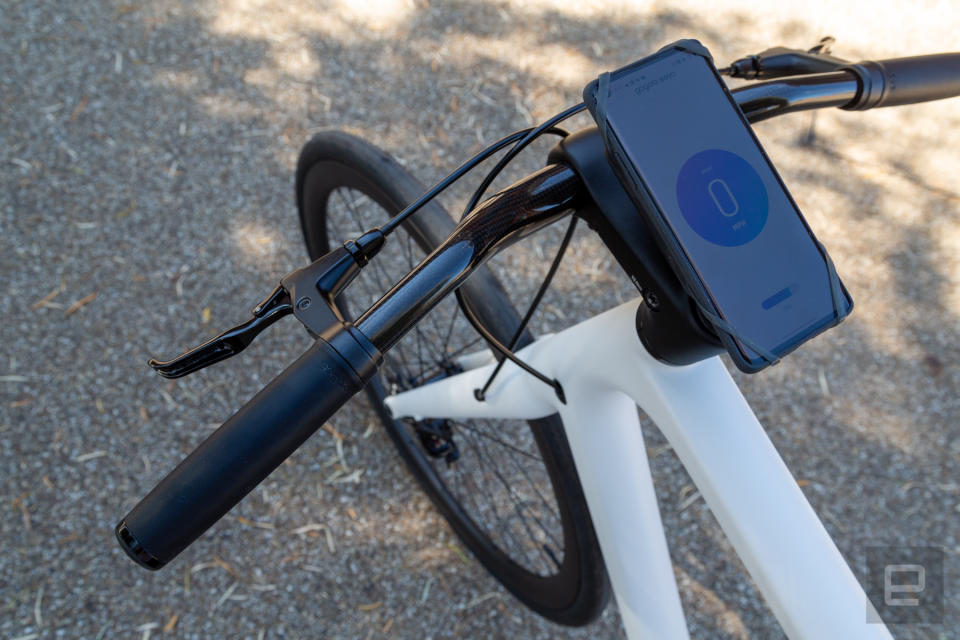
Unlike most e-bikes, you won’t find a display nestled into the frame or handlebar stem. The Eeyo 1s does ship with a rubbery smartphone cradle, though, that can seamlessly shift between portrait and landscape mode. That’s because the companion app is required to change absolutely anything on the bike. That includes unlocking it — there’s no physical power button — checking the battery and adjusting various settings, such as whether the bike should auto-lock once your Bluetooth connection has expired for 5, 10 or 15 minutes.
Gogoro isn’t the first to build an e-bike without a screen or physical controls. The mostly-excellent Cowboy that I reviewed last year was the same. Still, the company’s decision can occasionally frustrate. It takes a half-second for your phone to establish a Bluetooth connection with the bike, for instance, and another long-press to ‘unlock’ the motor. That’s not awful, but it feels strangely inefficient if you’re used to jumping on a bike and setting off immediately. I would have liked the option, too, to unlock the Eeyo 1s with a physical button sequence similar to VanMoof’s e-bikes. If the Eeyo 1s is locked and your phone runs out of battery, you have no option but to ride home with pedal power alone.
At first, I did yearn for a display. Gogoro’s companion app is well-designed (please Gocycle, take note) and easy to read at a distance, but a tad light on information. And, during torrential wind and downpours, I wanted to keep my precious OnePlus 8 somewhere a little more secure. But those feelings soon faded. I’m easily distracted by screens and found that its omission helped me stay both attentive and relaxed on the road.
If I had to choose between weight and smart features, I would pick the former every time.
In addition, the bike doesn’t have any integrated lights, alarm system, or built-in GPS tracking. It’s a simple package, for better and worse. I would have liked some front and rear lights, for instance, but appreciate that they would have added weight and required some extra cabling in the frame. I’ve written before about VanMoof’s security system which, while not impenetrable, helped cure my fear of bike thieves a couple of years ago. I don’t mind that the Eeyo 1s doesn’t have an alarm or GPS tracking, though. Gogoro’s e-bike is so expensive that I would never feel comfortable leaving it outside a cafe or store — even if it was protected by a system like VanMoof’s. It would be like leaving a Bugatti on a random side street.
Overall, I think Gogoro has taken the right approach. The bike feels refined and free of ‘nice to have but ultimately inessential’ clutter. Dropping all those features was necessary, too, to keep the Eeyo 1s so gloriously light. If I had to choose between weight and smart features, I would pick the former every time. Others might disagree, and that’s fine. Just like a Bugatti, Gogoro knows that its first e-bikes won’t appeal to everyone. “While other e-bikes look to solve utilitarian challenges, what we wanted to do was bring the fun and excitement into the ride,” Horace Luke, CEO of Gogoro said. “I gave the team a very simple thesis: I said, ‘give me a bike that makes me feel like I’m 18 again.’”
Performance
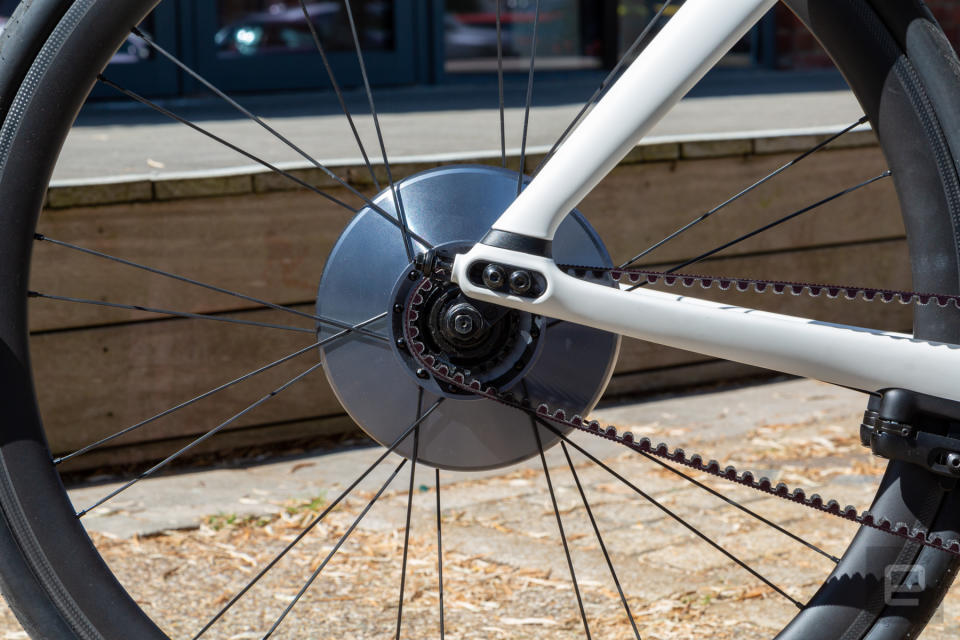
That metal cylinder I mentioned before? It doesn’t just contain the battery. Gogoro’s so-called Smartwheel platform also contains a 250W motor and all of the sensors required to monitor your speed and effort. I’ve never seen a system quite like it and was initially skeptical about how it would perform alongside the Gates carbon belt drive.
The Eeyo 1s has a top speed of 25KMH (15.5MPH) in Europe and 31KMH (19MPH) in the US. If those numbers sound familiar, it’s because they’re shared by almost every commuter e-bike on the market at the moment. In Europe, you don’t need a license, number plate or insurance provided the bike is capped at 250W and 25KMH. Most states in the US, meanwhile, have adopted a three-class system for electric bicycles. The lowest classification, which is for pedal-assist e-bikes with no throttle and a top speed of 32KMH, can be ridden anywhere that a normal bike is permitted including roads, multi-use trails and bike-only lanes and paths.
You can set your Home Region and software-controlled top speed through the companion app. (A pre-release version of the app let me pick between the US, Taiwan, Europe and Japan.) Even on the US setting, though, it’s difficult to reach the advertised top speed. The motor loses interest around 24-27KMH (15-17MPH) and, because the bike’s single gear is quite low, you can’t go any faster with sheer pedal power.
“Its sweet spot is 21-25KMH, which is the pace of most urban bike commuting in Europe.”
“The Eeyo 1 was designed for cities where stop-and-go traffic means riders need to be agile and fast, but they rarely have an opportunity to get up to high speeds,” a Gogoro spokesperson said. “Its sweet spot is 21-25KMH, which is the pace of most urban bike commuting in Europe.”
The company is right. The average commute is littered with traffic lights and pedestrian crossings. Stop. Start. Stop. Start. Cycling has always been potentially faster than driving because you’re able to weave through traffic and duck down side streets that are too narrow for cars. Still, you’re sharing the city with pedestrians and other road users, which makes it nearly impossible to reach and maintain the same speeds that you would hit in the countryside.

Handling and acceleration, therefore, are more important. Thankfully, the Eeyo 1s nails both. Step on the bike, press on the pedals and boom — the 250W motor will send you flying forward with a satisfying burst of speed. It’s like a 100-meter sprinter exploding out of the blocks. I never once felt like the bike was moving so fast that I might lose my balance and veer into a nearby bush, though. The carbon frame and sporty handlebars make the bike feel agile, too, when you’re navigating tight turns or maneuvering around pedestrians who stepped into the road without looking.
Better yet, the Eeyo 1s is a fantastic hill-climber. Unlike VanMoof’s S3, the motor doesn’t ease off when you reach the start of a difficult slope. If anything, it tries harder. That’s important because there’s no turbo button to fall back on if your legs start to give out. The assistance is so impressive that I often felt like a drug-fuelled Lance Armstrong tackling the mountain stages of the Tour de France. It was almost too easy (yes, I can’t believe I’m saying that either) and I felt guilty whenever I soared past other cyclists that had a mixture of shock and envy on their faces.
Unfortunately, going downhill is a different story. I live in a suburban area littered with short, steep climbs and long, gradual declines. When I reached the top of a particularly tough ascent, my natural reaction is to take a deep breath and ride down the other side as quickly as possible. If you gain enough momentum to eclipse 32KMH (thanks gravity!) the bike’s motor will disengage and enter a “protection mode” that stops it from turning back on until you’ve slowed down to roughly 11KMH (7MPH).
The assistance is so impressive that I often felt like a drug-fuelled Lance Armstrong.
Both thresholds are awfully impractical. If you’re coasting down a hill, it’s easy to surpass 32KMH with gravity alone. You can pepper the brakes, of course, to keep your speed in check and prevent the bike from entering Protection Mode. But that feels unnatural and a wildly inefficient way of using the planet’s natural terrain. Waiting for the bike to hit 11KMH is equally painful, especially if you’re about to start another uphill climb. Other e-bikes I’ve tested don’t have this problem — they shut off when they reach the software-mandated top speed and re-engage as soon as you duck below it again.
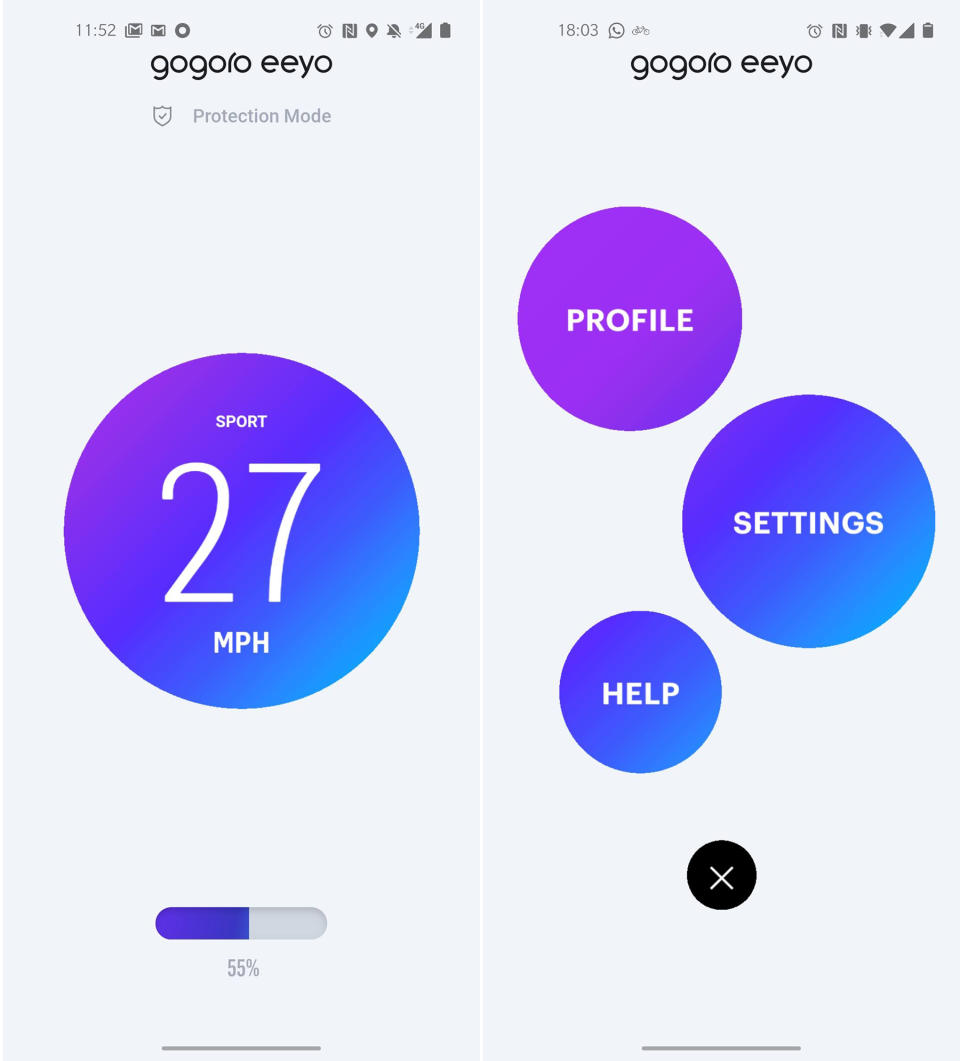
“When we cut the motor power of [the] Smartwheel, the motor becomes a generator,” a Gogoro spokesperson told Engadget. “[The bike] then waits until the voltage generated by the motor is lower than the voltage of the battery pack to resume the motor and power assist. If we resume [at] speeds [higher] than 12KMH, the higher voltage from the motor can damage the battery pack.”
Normally, this would be a deal-breaker. But the Eeyo 1s is dramatically lighter than most e-bikes and is, therefore, viable to ride without any electrical assistance. It’s a wonderful but alien feeling. Most pedal-assist bicycles aren’t much fun to ride on anything but the highest power level setting. They’re simply too heavy and force you to pedal just as hard, if not harder than you would on a conventional road bike. And if the motor is switched off completely? Prepare for a serious workout, my friend. The Eeyo 1s, meanwhile, is lighter than the non-electric bicycle I normally ride. That meant I didn’t mind when the motor occasionally cut out, or reduced its assistance, because it still required less effort than my usual second-hand clunker.
When the motor does come on, it isn’t very discrete. The activated Smartwheel makes a light whistling noise that can be heard by anyone in a four-meter radius. The sound isn’t awful, but it’s loud enough to spoil an otherwise silent ride through a park filled with rustling trees and birdsong. On the flip-side, the whistling acts like a low-key bell for pedestrians and other cyclists who might not be aware of your fast-approaching presence. The sound also lets you know exactly when the motor is and isn’t engaged. That’s critical because the bike doesn’t have a readout like Gocycle’s brilliant ‘cockpit’ display, or a segment in the app that shows how hard the SmartWheel is working.
Range

Gogoro says the Eeyo 1s should manage 40-55 miles, (64-89KM) on a single charge. That’s roughly the same as other city-centric e-bikes I’ve tested including the Cowboy and Gocycle GXi. For comparison, VanMoof claims its S3 can manage 37 to 93 miles (60 to 150 kilometers), and I averaged roughly 50 miles while testing that bike earlier this year.
I mapped out an 11.5-mile route in my local area that included an elevation gain of 447 feet (roughly 136 meters). On the first day, I completed the trip in 48 minutes and only used 10 percent of the bike’s battery. In theory, that meant I could repeat the trip five times before the battery ran out. A few days later, though, I used 24 percent completing the same route in an almost identical time.
Did the mist-like drizzle play a part on the second outing? Or was I simply pedaling harder on the first day? It’s hard to say. During my test period, though, I was able to eke out 52 miles (84 KM) on a single charge, which I think is perfectly respectable for a commuter bike.
The bike comes with a horseshoe-shaped charger that effortlessly slips on to the outside of the Smartwheel.
If you’re willing to ride in Eco mode, too, you can extend the Eeyo 1s’ range even farther. With this power setting, the bike only lost 6 percent of its charge during my 11.5-mile route. Curiously, the time I spent completing the loop was almost identical to the one I recorded in Sport mode, too. I put this down to chance — sometimes you’re just lucky and don’t have to wait at any traffic lights — and how easy the bike is to ride with only minimal motorized assistance.
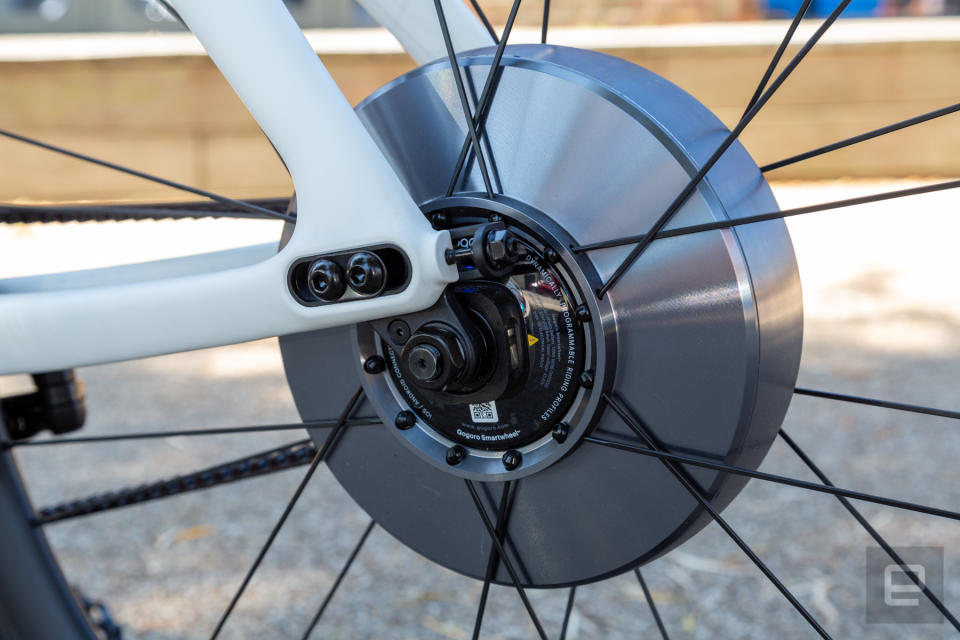
The Smartwheel is technically removable, but the process is time-consuming and the company doesn’t encourage it. Instead, I suspect every Eeyo 1s owner will keep and charge the two-wheeled machine in their home, garage or office. The bike comes with a horseshoe-shaped charger that effortlessly slips on to the outside of the Smartwheel. The metal canister never actually moves — the spokes and tire simply rotate around it — so the charger attaches via the same spot every time. It’s an utterly brilliant design that also ensures the wonderfully-sleek frame isn’t spoiled by charging ports and rubber flaps.
The bike’s charging time is equally impressive. The Eeyo 1s is so light that it only needs a 123Wh battery — much smaller than the ones offered on the Cowboy and VanMoof’s S3 — to achieve a competitive range. The smaller battery size means the bike only needs 2.5 hours to go from zero to 100 percent. That could be helpful if you’re working in the office and only realize in the middle of the afternoon that your Eeyo 1s could use a top-up.
Portability
Normally, I would explain how impractical it is for many people to own an e-bike with a non-removable battery. If you live at the top of an apartment block, for instance, you probably don’t fancy lugging a heavy bicycle up the stairs every day. At 12KG (26.4 pounds), though, the Eeyo 1s is remarkably light. That special ‘open-frame’ design isn’t just for looks, either. It’s been designed so you can easily slip an arm through and carry the bike over one shoulder. I live in a ground-floor apartment but tried carrying the Eeyo 1s up a few different staircases littered around Portsmouth, a city in England known for its historic dockyard. Even for someone like me, who has the physique of an udon noodle, it was almost effortless.
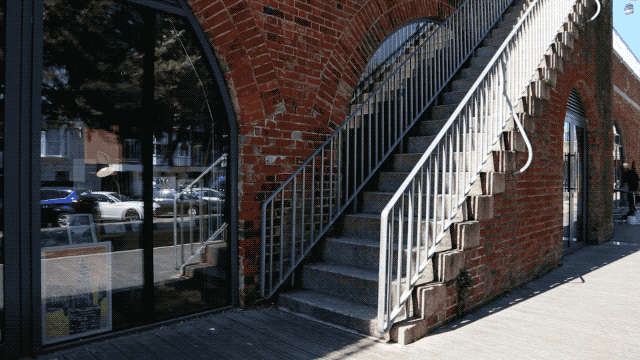
I haven’t boarded a bus or train since the COVID-19 pandemic started. Under normal circumstances, though, I can imagine how useful the Eeyo 1s would be as a so-called ‘last mile’ solution. Gogoro’s bike should be easy to pick up and carry onto an overground train, for instance, or down the stairs that lead to a subway station. The weight and thoughtful frame design doesn’t make the bike any smaller, though. That means you’ll still need enough space to charge the bike in your home, shed or garage. And I know some employers don’t like their staff charging a rain-soaked e-bike next to their desk. Even so, the Eeyo 1s feels like a bike that would be practical and enjoyable to own in a bustling city environment.
Wrap-up
Gogoro has designed the Eeyo 1s for a very specific group of people. One that wants — no, craves — an e-bike that is light enough to carry around on one arm. These customers are prepared to forgo some fancy smart bike features, including an alarm system and integrated lights, to acquire this dream two-wheeler. And they want that weight to produce a ride that’s wicked fast from a standing start and easier to ride both up hills and without motorized assistance. If you’re one of these people, the Eeyo 1s delivers. It’s seriously expensive, even by e-bike standards, but comes with a carbon frame that simply isn’t offered by tech-centric rivals such as VanMoof.
Other carbon fiber e-bikes exist. You can buy Ribble’s Endurance SLe, for instance, or a handful of different models from brands like Orbea, Specialized and Focus. These are proper road bikes, though, with racing-style ‘drop’ handlebars. They’re meant for recreational riders who like to blitz through 30 miles on the weekend, rather than design-conscious city dwellers. You can, of course, ride a racing e-bike to work. Gogoro’s first bicycles are meant for a slightly different type of cyclist, though — one that will view its carry-centric frame design as a major asset, rather than a head-turning gimmick.

The Eeyo 1s has some drawbacks, though. The ‘Protection Mode’ is frustrating and the app-based control scheme isn’t ideal in a downpour. Otherwise, I’ve loved my time with Gogoro’s carbon bike. It’s ridiculously fun to ride (provided you stay under that speed threshold), quick to charge, and practical for anyone who lives in a flat or regularly wants to lift their bike onto a car rack or wall stand. There’s room for improvement, but Gogoro can be proud of its first effort in the electric bicycle space.



